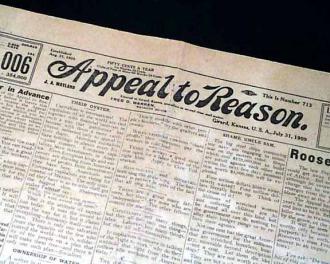
Many observers may have been surprised that Bernie Sanders, a socialist, won primaries and caucuses in the prairie and plains states of Oklahoma, Kansas, and Nebraska (states that have all consistently voted Republican in recent presidential elections), as well as Minnesota and Colorado. A glance at the history of progressive and radical political groups in these states, however, will show that there has been a long and colorful tradition of left-wing activism since their earliest days as part of the United States.
Oklahoma, in its early years in the Union, was a center of Socialist Party strength. According to Jim Bissett of the Oklahoma Historical Society, it “consistently ranked as one of the top three state socialist organizations in America.” Being an overwhelmingly rural state, the party’s emphasis was on farmers’ issues. It was able to connect to those people most adversely affected by the ravages of capitalism.
Bissett, who is also the author of a book on agrarian socialism in the state, recounts: “Every summer, thousands of the faithful gathered at socialist encampments to be revitalized by several days of music, entertainment, and speakers. Dozens of county and local socialist newspapers served the movement’s communication needs, as did a special Oklahoma edition of the national socialist weekly, The Appeal to Reason.”
At the same time, the spirit of resistance to corporate domination made major advances in most of the Great Plains states, including Kansas, Nebraska, and Colorado. By the 1890s, the oppression that the small farmers of the region suffered at the hands of the banks, railroads, and food processors combined with drought conditions to spark the growth of Farmers Alliance and other groups.
In the summer of 1892 many activists came to Omaha, Nebraska and joined together in the formation of the People’s Party, better known as the Populists. They adopted a platform that declared that “wealth belongs to him who creates it,” and called for the unlimited coinage of silver, which would make money more readily available for the poor to pay off their debts. The capitalists only allowed the coinage of gold, which favored their interests. The Populists also demanded the nationalization of the railroads, a graduated income tax, and the secret ballot, among many other issues. The convention even expressed its support for a strike of the Knights of Labor clothing workers in Rochester, New York.
Many of the party’s supporters were motivated by Kansas activist Mary Elizabeth Lease’s supposed exhortation to “raise less corn and more hell.” That year the Populists ran James B. Weaver for president. He received over a million votes, about one out of every twelve cast and secured twenty-two electoral votes – those of Kansas, Colorado, Nevada, Idaho, and one each from North Dakota and Oregon.
The party was strongest in Kansas, where it managed to capture control of the state legislature. Overall in 1892, the party elected five members to the U.S. Senate, ten members of the House, three governors, and over 1,500 local officials. (3) These members came predominantly from Kansas, Nebraska, Minnesota and Colorado.
Minnesota’s radical politics in the twentieth century centered on the Minnesota Farmer-Labor Party (FL). As its name suggests, the party brought together city workers and farmers. Its main goals were, in the words of Warren Creel, its former educational secretary, to “unite into a political organization all persons engaged in agriculture and other useful industry, and those in sympathy with their interests, for the purpose of securing legislation that will protect and promote the economic welfare of the wealth producers.”
Creel wrote that the party’s ultimate aim was “to rescue the government from the control of the privileged few and make it function for the use and benefit of all by abolishing monopoly in every form.”
At the height of its influence in the 1930s it was able to elect three governors, four U.S. Senators, eight U.S. House Representatives, and a majority of the state legislature. It eventually merged with the Minnesota Democratic Party in 1944.
When one studies the history of the prairie and western states, one finds a rich tradition of agrarian radicalism and labor militancy. The seven decades since World War II may have been a time of right-wing supremacy highlighted by the drive to suppress popular resistance to corporate domination, but the Sanders campaign is a major factor in re-igniting the flame of struggle for a more just society.
Photo: Socialistworker.org












Comments